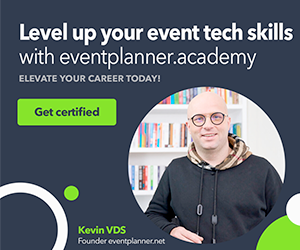Transcript
We like to make things very difficult for ourselves. We think of complex solutions while a simple approach oftentimes works best. Jan-Peter Bogers is an expert in simplifying things.
Hi, Jan-Peter. Welcome in our studio.
Thank you very much.
You did write a book about simplifying things and why is it people like to make things so complex, so difficult for ourselves?
Well, it sort of happens automatically. Usually, we start with an idea and ideas are inspiring. We’re going to invent something new. We’re going to organize something different. Then, the idea becomes a plan. We start doing things. The first checklists are coming our way and then suddenly, our plan and our idea become a project and when it becomes a project, the energy often goes down. We have to think about time, money, other people with other opinions and along the road, it gets more and more complex and we sort of drown in our own projects.
That’s just like how we organize events, mainly.
I guess so, yes.
Yes.
Could be.
So how do we deal with that? What could we do differently, then?
Well, the most important thing about simplifying is going back to your original idea. Why did we start this project in the first place? Why did we organize this event in the first place? And then we ask the questions, what do we really, really need to get this project organized or this event organized? And what kind of things we don’t need or don’t need yet.
Yes.
That brings us to the core or the essence of our project and when we know the essence of our project, you can more easily move into action.
Could you make that a little bit more concrete? If you take a concrete example, how would that work?
Yes. Well, My own favorite tool is making projects smaller.
Yes.
Not for the end result because our ambition remains the same but just for the startup of a project. For example; you want to start a museum. Now, a museum sounds like something huge and big. But what would be the smallest type of museum? What’s the smallest thing you could call a museum? What do you need for that?
Maybe some piece of art and somebody who’s looking at it?
Exactly, yes. Exactly, those two things. You need pieces of art, paintings, whatever and you need people who are going to look at it. So when you’ve got that, you’ve started your museum. Pretty small but you could do that in your attic or you could put in your garden or you could do it online but you’ve got your museum. And then you also are building on experimenting with your museum. So after that, you can go, grow it larger and larger. So our ambition doesn’t get smaller. Same with events. What do you need for an event? Speakers and people who are going to listen to those speakers. You need an audience. Those are the most essential parts of an event. All the rest is extra. It’s not unimportant. I mean, we like good coffee. We like a great lunch and a great ambience but the essence is speakers and listeners.
So that will mean that you first focus on those things.
Exactly. Or at least you find a starting point. It can also be… I organized an event and it got complex. So the first thing we did was setting the date, two months after our meeting. So that really put us in a position where we had to take action because two months is very short and we have got a date set. You know, okay, we can take those speakers because they’re available and those are not. Or you could start; I have to have this speaker on my event. And then the date follows from choosing the speaker.
Yes.
But you have to have a starting point. So that’s what I call… Well, untying the knots when you’ve got a lot of decisions to make, you have to start with one and it gets complex because A depends on B. B depends on C but C depends on A. So where do you start?
Yes, and choose just one starting point so you get off.
Exactly, and the starting point, you can find by going to the essence, the core of your project. If the core is, well, we want this key note speaker and we build the event around him, that’s the point where you start.
Most events start with a venue but that’s not the most important thing.
No. Unless you… For example, it could be the most important thing if you want to have a really big event and not many venues would be suitable.
Okay.
If that would be the core of your project; we want it to be huge, then you could start with your venue. But most of the time, you start with content, of course, of your event and then it’s not logical to start with the venue in the first place. It depends on the project.
But it’s not only simplifying the project itself but also the project team, for example. Because in many situations, there is a very big team which makes it very complex to make decisions.
Yes, people are one of the most complicated factors. Because they go about money, about time, about rules and regulations and then they also all have different opinions. So that makes it quite complicated. And often, in organizations or in project teams, everybody who wants to say something about the project is joining the project team. And you have to ask yourself, who do you really need in a project team?
Yes.
Not to skip people or to pass by them but what do we need for our project? And who can provide that, with expertise, with… Well, hours to spend on the project.
So keep it lean and mean.
Keep it lean and mean and often, we don’t need as many people on the project as we think or as they think, themselves.
Yes. One last technique maybe, I read in the book. It was about writing the steps for the project on post-it notes.
Yes.
Can you explain what that is about?
Yes. I call them mini project plans and it has to fit on a post-it like this size.
Yes.
It’s like five to seven steps of a project and each step has to be actionable and concrete. And if you make a project plan on a small post-it, you have to go to the essence of your project and you have to really narrow down what you need and what actions you have to take. You can write down, discussion, on a post-it. Just the actions you have to take. So you ask yourself, what do I really need? What steps do I really have to take to get this project or this event done?
Book the speaker, invite the audience, book the venue and just as simple as that.
Yes, like that. So I would start with, what’s the most important message of the event?
Yes. Then who will be the key note speaker, et cetera. Just the way you mentioned it, yes.
Okay.
And of course, all those steps can have a sub plan as well but they also should fit on another one post-it.
Okay. Unfortunately, the book is only available in Dutch but you do have some information online, I did understand, in English.
Yes, for another event, I translated some parts in English. There’s a short abbreviation of the book in English and there’s a preview example of the book in English. They’re online at www.versimpelen.info.
Yes.
Slash English.
That was Dutch. So…
That was Dutch, yes.
…we will put the link below the video.
Exactly. Versimpelen is the Dutch word for simplifying. People will eventually find it somewhere, I guess.
Okay, great. Thank you, Jan-Peter, for coming over.
Thank you very much, Kevin.
And you at home, thank you for watching our show. I hope to see you next week.







